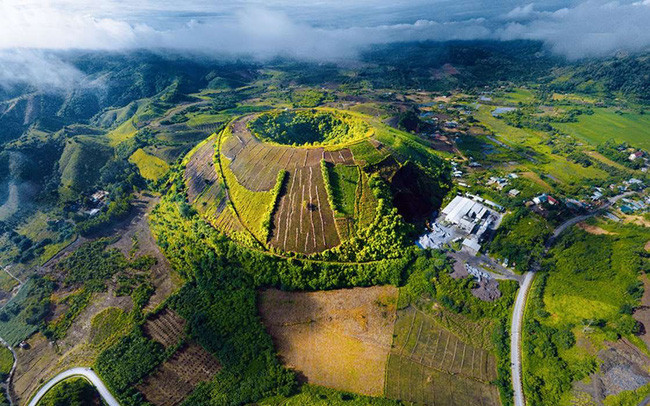
Dak Nong Province’s development lanning for the period 2021-2030, with a vision to 2050, identifies tourism as one of the three pillars of economic development besides industry and sustainable agriculture.
Located at the gateway to the Central Highlands, Dak Nong has many advantages in tourism resources, as it converges values of geology, geomorphology, archeology, culture and biodiversity of international and regional significance. Dak Nong has mountains and hills, mixed with vast forests, spanning coffee and pepper farms and beautiful pristine fields.
With its potentials and advantages, tourism is identified as one of the three pillars of economic development. Dak Nong strives to become an attractive regional tourist destination by 2030 and a national tourism center by 2050.
The unique elements that create the "brand" of Dak Nong tourism include the UNESCO Dak Nong global geopark, which has a system of more than 100 caves, with the longest and widest scale in Southeast Asia, distributed mainly in the Krong No area. The caves were discovered in 2007 and set a Southeast Asian record by the Japan Volcanic Cave Association in terms of scale, length and uniqueness.
According to scientists, this place has hundreds of caves. The caves also contain many secrets about formation mechanisms, mineral complexes, biodiversity and archaeological sites. This area also has paleontological heritages such as ammonite fossils, tree molds in basalt rock, and poetic lakes besides unique volcanic craters such as Nam Blang, Nam Kar, Bang Mo and majestic beautiful waterfall systems.
With diverse terrain alternating between valleys, plateaus and high mountains, Dak Nong has many unique and majestic natural landscapes such as Dak G'lun waterfall, Dak Búk So waterfall, D'ray Sap waterfall, Gia Long waterfall, Trinh Nu waterfall, Truc lake, and West lake. In particular, the Ta Dung National Park – an UNESCO Global Geopark - is one of the attractive places that can develop many types of tourism.
Dak Nong also has Ta Dung Lake, which is dubbed the "Ha Long Bay on the plateau" with an area of nearly 5,000 hectares of water surface and more than 40 islands and peninsulas, creating an extremely unique natural landscape.
The Nam Nung Nature Reserve, Ta Dung National Park, D'ray Sap Special Use Forest and the southern part of Yok Don National Park (Dak Lak) are places that preserve unique values of biology diversity of the UNESCO Dak Nong Geopark.
With an extremely rich and diverse flora and fauna system with many rare species listed in the red books of Vietnam and the world such as elephants, tigers, bison and many species of primates (white-cheeked langurs, black douc-shanked doucs, hornbill,...).
Dak Nong is home to many ethnic minority groups with a long history of residence, daily life, and productive labor of the people associated with the mountains, forests, fields, and the mountain and forest civilization.
Dak Nong preserves many cultural heritages with typical values such as gong heritage and gong cultural performances, traditional musical instruments, legendary epics, khan stories, various types of festivals, folk songs, folk dances and traditional crafts such as brocade weaving, sculpture and many unique folk games that reflects the unique lifestyle and living methods of the local ethnic minorities, and at the same time shows the unique beauty of Dak Nong. In particular, the restoration of the Ot N'Drong epic of the M'nong people has attracted the attention of tourists.
In addition, Dak Nong has 12 relics ranked by the State, including 1 special national monument, 8 national monuments and 3 provincial monuments.
Dak Nong’s development planning for the period 2021-2030, with a vision to 2050, identifies tourism as one of the three pillars of economic development besides industry and sustainable agriculture.
Specifically, by 2025, the province will fork a number of key tourist destinations associated with the natural landscape and cultural heritage of Dak Nong; early complete planning for key tourist areas (Ta Dung, Geopark...); develop a number of unique tourism products and models. By 2030, the province will form tourist routes associated with Dak Nong Geopark; invest in some key destinations; and complete investment in key tourist areas.
By 2050, tourist routes of Dak Nong Geopark will be developed into a continuous system, with diverse natural landscapes and cultural heritage, becoming a national tourism center.
Dak Nong determines to develop tourism to truly becomes the province's driving economic sector, contributing to hunger eradication, poverty reduction and socio-economic restructuring.